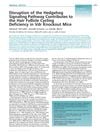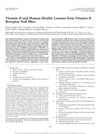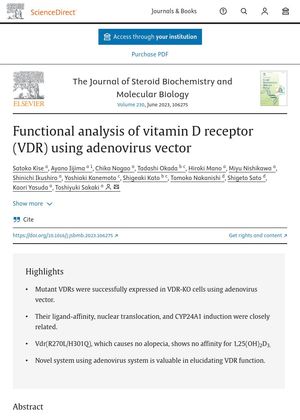TLDR The study found that certain mutations in the vitamin D receptor can cause rickets and potentially affect hair growth.
The study investigated the function of the Vitamin D receptor (VDR) and its relationship with alopecia using adenovirus vectors (AdVs). The researchers generated genetically modified rats with different VDR mutations and used three systems to evaluate the VDRs: a split luciferase system to examine ligand-binding ability, investigation of ligand-dependent nuclear translocation in HaCaT-VDR-KO cells, and examination of CYP24A1 transcription induction by ligand addition using qPCR. The study found that mutations in the VDR-RXR interaction domain can result in alopecia, while mutations in the ligand-binding domain do not. The study concluded that AdVs expressing VDR could be a promising tool for elucidating VDR functions, particularly in relation to alopecia.
 20 citations
,
July 2017 in “Scientific Reports”
20 citations
,
July 2017 in “Scientific Reports” A single amino acid change in the vitamin D receptor can disrupt its function and lead to hair loss.
109 citations
,
June 2011 in “Molecular and Cellular Endocrinology” Vitamin D receptor mutations can cause alopecia by affecting hair growth genes.
 53 citations
,
May 2010 in “Journal of Cellular Physiology”
53 citations
,
May 2010 in “Journal of Cellular Physiology” Mice without Vitamin D receptors have hair growth problems because of issues in the hedgehog signaling pathway.
 1533 citations
,
October 2008 in “Endocrine reviews”
1533 citations
,
October 2008 in “Endocrine reviews” Mice without the vitamin D receptor have bone issues and other health problems, suggesting vitamin D is important for preventing various diseases in humans.
115 citations
,
December 2001 in “Endocrinology” Expressing the human vitamin D receptor in skin cells prevents hair loss in certain mice.
 October 2023 in “Scientific Reports”
October 2023 in “Scientific Reports” Gene therapy helped rats with a specific type of rickets grow hair without severe inflammation.
December 2025 in “Journal of Cell Communication and Signaling” Vitamin D receptor is crucial for hair health and may help treat hair loss.
January 2025 in “International Journal of Molecular Sciences” Non-liganded Vitamin D Receptor is crucial for healthy skin and hair.
 April 2023 in “Research Square (Research Square)”
April 2023 in “Research Square (Research Square)” Gene therapy with a vitamin D receptor gene improved hair growth in rats with a type of rickets-related baldness.
November 2023 in “Biomolecules” The research showed that Vitamin D and its receptor are important for healthy bones and normal hair and skin in rats.






